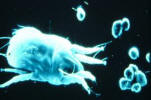Home
A Broad Introduction
Allergy Concepts
Food Issues
Asthma
Rhinitis & Hay Fever
Eczema
Children & Infants
Allergy to Animals
Finding Answers



|
It will be obvious
from the many references to the “Few Foods” diet that many readers
will expect some guidance on this aspect of allergy and intolerance.
This is difficult because there is a definite risk that someone will
continue indefinitely on a diet which is designed only to be endured
for a few weeks in order to find out if the problem, whatever it may
be, will improve. Unfortunately it is quite impossible to foretell
what some misguided person might do, and it would be dreadful if,
for example, a mother inflicted a restricted diet on her child, and
even though there was no
improvement after two weeks persisted
indefinitely until the child suffered from malnutrition, starvation,
or worse. Further, I would probably be accused of being responsible
and be blamed instead of the misguided patient or mother.
 For the above reasons a specific diet is not being detailed, and
only the principles of this test diet outlined. It must also be
emphasised that the family doctor should be involved in trying out
restricted diets, especially when for children, and a dietitian
should also be involved if available. It is unfortunate that there
are so very few dietitians with knowledge of the importance of food
allergy and intolerance, and the use of trial diets in diagnosis of
food intolerance. The British Dietetic Society do not accept that
beef and beef extracts should also be rigidly excluded from milk
free diets, but in my extensive experience about a quarter of the
milk intolerant patients cannot tolerate beef either. It is
difficult to understand why this simple fact is not recognised,
because milk comes from beef and contains very similar proteins. It
was gratifying recently to have confirmation of my experience from
the top American experts in food allergy and intolerance that beef
also causes problems. The occasional role of milk in causing
constipation is also seldom recognised, but recently one enlightened
authority stated that milk as a cause should be excluded before
prescribing laxatives for children. For the above reasons a specific diet is not being detailed, and
only the principles of this test diet outlined. It must also be
emphasised that the family doctor should be involved in trying out
restricted diets, especially when for children, and a dietitian
should also be involved if available. It is unfortunate that there
are so very few dietitians with knowledge of the importance of food
allergy and intolerance, and the use of trial diets in diagnosis of
food intolerance. The British Dietetic Society do not accept that
beef and beef extracts should also be rigidly excluded from milk
free diets, but in my extensive experience about a quarter of the
milk intolerant patients cannot tolerate beef either. It is
difficult to understand why this simple fact is not recognised,
because milk comes from beef and contains very similar proteins. It
was gratifying recently to have confirmation of my experience from
the top American experts in food allergy and intolerance that beef
also causes problems. The occasional role of milk in causing
constipation is also seldom recognised, but recently one enlightened
authority stated that milk as a cause should be excluded before
prescribing laxatives for children.
 The "Few Foods Diet” is a test diet to exist on for two or three
weeks, and is the only practical way to find out if avoiding all
other foods will bring about improvement. It is of such short
duration that there is no question of vitamin or mineral
deficiencies resulting from it. Restricted diets require a great
deal of motivation, cooperation, and perseverance, and should be
accompanied by a diet diary recording everything that passes their
lips, including all supplements as well as medicines, and even
toothpaste etc. It is not uncommon for symptoms to get worse in the
first few days, and cravings can be a problem. I find it is very
helpful; to arrange that the patient reports weekly by phone to
doctor or dietitian to discuss progress and problems, as otherwise
they can lose their initial enthusiasm. The "Few Foods Diet” is a test diet to exist on for two or three
weeks, and is the only practical way to find out if avoiding all
other foods will bring about improvement. It is of such short
duration that there is no question of vitamin or mineral
deficiencies resulting from it. Restricted diets require a great
deal of motivation, cooperation, and perseverance, and should be
accompanied by a diet diary recording everything that passes their
lips, including all supplements as well as medicines, and even
toothpaste etc. It is not uncommon for symptoms to get worse in the
first few days, and cravings can be a problem. I find it is very
helpful; to arrange that the patient reports weekly by phone to
doctor or dietitian to discuss progress and problems, as otherwise
they can lose their initial enthusiasm.
 The “Few Foods Diet” is a very simple diet limited to the few foods
which very seldom cause intolerance or allergy, and is intended to
be endured for only two or three weeks. Rice is the backbone of the
diet because rice very seldom causes problems in the West, where
wheat, other cereals, and potato are the main source of
carbohydrates. The fewer the foods included in the diet the less
chance there is that a food which is causing trouble will be
included, therefore the ideal “elimination” diet could be to exist
on nothing but rice and water for a fortnight !! No improvement
after sticking rigidly to this diet means that intolerance to foods
is not the cause of the problem, whatever it may be. The unlikely
alternative, especially if symptoms actually got worse on the diet,
is that the cause of the problem is one of the few foods. In this
situation it might be worth while, before discarding the idea of
food intolerance altogether, to try reversing the diet and avoiding
the few foods instead, but this is a very uncommon situation. The “Few Foods Diet” is a very simple diet limited to the few foods
which very seldom cause intolerance or allergy, and is intended to
be endured for only two or three weeks. Rice is the backbone of the
diet because rice very seldom causes problems in the West, where
wheat, other cereals, and potato are the main source of
carbohydrates. The fewer the foods included in the diet the less
chance there is that a food which is causing trouble will be
included, therefore the ideal “elimination” diet could be to exist
on nothing but rice and water for a fortnight !! No improvement
after sticking rigidly to this diet means that intolerance to foods
is not the cause of the problem, whatever it may be. The unlikely
alternative, especially if symptoms actually got worse on the diet,
is that the cause of the problem is one of the few foods. In this
situation it might be worth while, before discarding the idea of
food intolerance altogether, to try reversing the diet and avoiding
the few foods instead, but this is a very uncommon situation.
 Improvement means that a food or foods which is not being eaten may
be the cause of the problem, so the next step is to introduce foods
one by one to find out which foods will repeatedly cause the
symptoms to recur. Instructions regarding dietary challenges in the
diagnosis of food intolerance have already been mentioned in the
section on tests, together with severe warnings about the dangers of
anyone with known food allergy experimenting with diets. Improvement means that a food or foods which is not being eaten may
be the cause of the problem, so the next step is to introduce foods
one by one to find out which foods will repeatedly cause the
symptoms to recur. Instructions regarding dietary challenges in the
diagnosis of food intolerance have already been mentioned in the
section on tests, together with severe warnings about the dangers of
anyone with known food allergy experimenting with diets.
The shorter
the interval between eating the food on test and the reaction to it
the more likely this is an important intolerance, but the
possibility that the reaction having taken place by chance is so
high that, unless the reaction was very quick and severe, it is
essential to repeat the test later to find out if the same amount of
the same food will cause the same reaction after the same delay
time. In fact the diagnosis is usually only definite after three
test feeds because reactions are often delayed to the next day.
The
whole process can be tedious and frustrating, and needs
perseverance. Sometimes accidental exposure, or intentional challenges
organised by a partner, will provide conclusive evidence, but
finding out what was in a dish in a restaurant is often very
difficult.
 Lamb is the most suitable meat as sheep still eat mainly grass and
sometimes turnips and other vegetables,. Welsh, Scottish or New
Zealand lamb is very suitable, but battery lambs are to be avoided.
Similarly, battery chickens and other poultry are taboo, but free
range poultry and eggs and any sort of game should be acceptable.
Fish or eggs are allowable unless allergic, as shown by
skin testing or bitter experience. Most vegetables and fruits are
allowable, with the exception of all cereals, potato, tomato,
peppers, peas, beans, and citrus fruits, unless already aware that
some items are not tolerated. Lamb is the most suitable meat as sheep still eat mainly grass and
sometimes turnips and other vegetables,. Welsh, Scottish or New
Zealand lamb is very suitable, but battery lambs are to be avoided.
Similarly, battery chickens and other poultry are taboo, but free
range poultry and eggs and any sort of game should be acceptable.
Fish or eggs are allowable unless allergic, as shown by
skin testing or bitter experience. Most vegetables and fruits are
allowable, with the exception of all cereals, potato, tomato,
peppers, peas, beans, and citrus fruits, unless already aware that
some items are not tolerated.
Problems with this temporary test diet are often about what to have
for breakfast, packed lunch, and so on. Rice Crispies (caution is
advised as there are several ingredients other than rice in this
product), rice cakes,
and rice milk are very suitable but boring. Many gluten free or
wheat free products contain potato flour, which can create more
difficulties. Gluten free does not mean wheat free unless so stated.
Leading supermarkets, especially Tesco, have a section entirely
devoted to dietary products which is getting bigger, and will supply
“free from” lists on request.
Advice from other websites is variable
in quality. The Coeliac Society website is very comprehensive and
full of good advice, but directed specifically to gluten avoidance.
For food intolerance and allergy the website resource at
www.foodsmatter.co.uk is
full of useful information for management of all food problems. |

